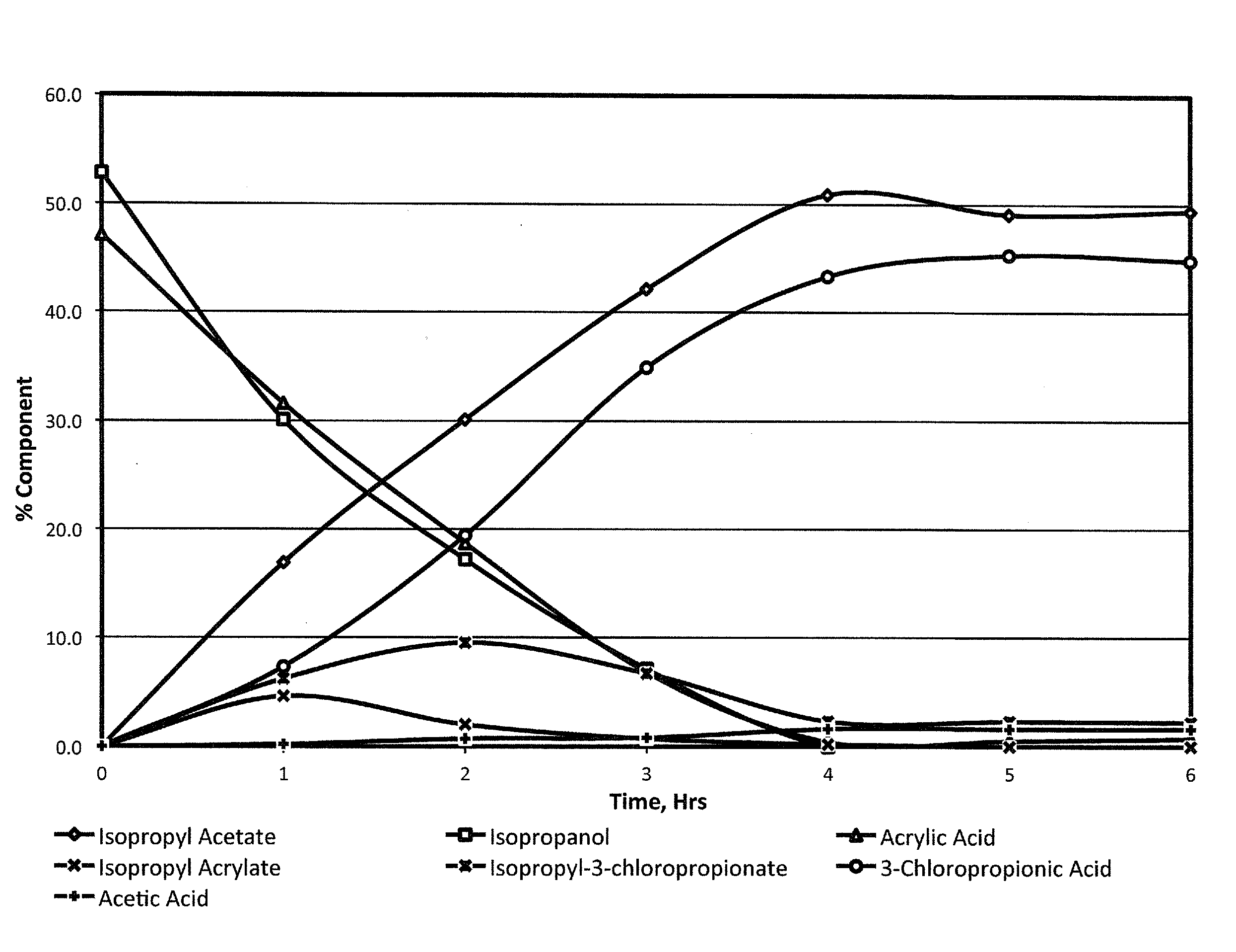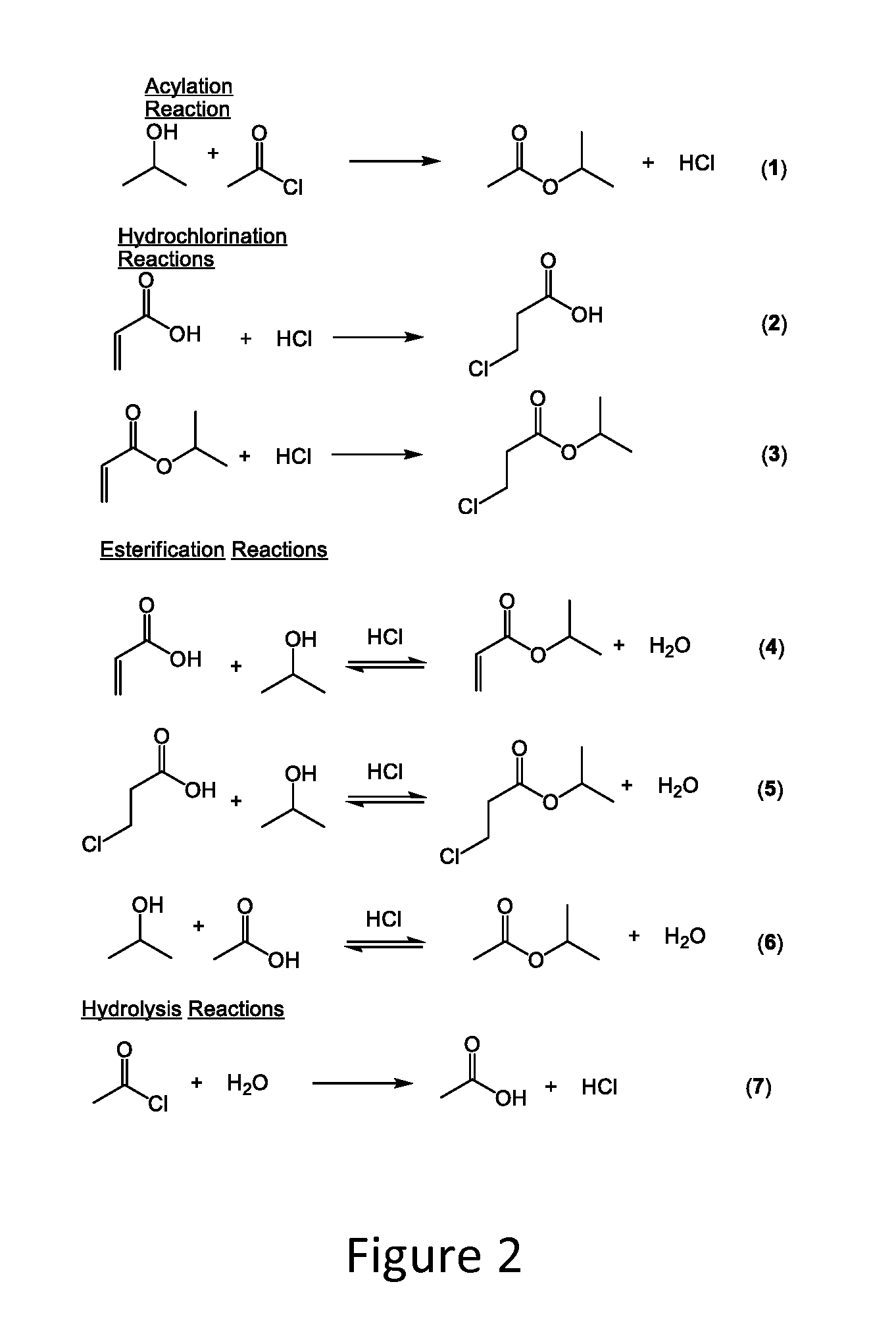Hydrochlorination of electron-deficient alkenes
a technology of electron deficiency and hydrogen methyl alkene, which is applied in the preparation of halogenated hydrocarbons, carboxylic compound preparations, organic chemistry, etc., can solve the problems of difficult to reduce the underlying chemistry to practice on an industrial scale, dangerous handling, and anhydrous hcl is a rather expensive raw material
- Summary
- Abstract
- Description
- Claims
- Application Information
AI Technical Summary
Benefits of technology
Problems solved by technology
Method used
Image
Examples
example 1
Production of 3-chloropropionic acid
[0054]Acrylic acid (72 g; 1 mol) was mixed with isopropanol (66 g, 1.1 mol; 1.1 eq). The mixture was cooled to <15° C. in an ice bath. Acetyl chloride (86.5 g, 1.1 mol; 1.1 eq) was added dropwise from an addition funnel over 4 hours while maintaining the temperature <20° C. The clear solution was stirred for one hour at <20° C. before warming to room temperature and stirring for 16 hours. The excess HCl was removed by a sub-surface nitrogen sparge. The pressure was reduced to 100 mm Hg and the pot temperature increased to 110° C. to remove isopropyl acetate. Hexane (200-m1) was added and the temperature reduced to 20-25° C. to induce crystallization. The slurry was further cooled to 5-10° C. before the product was isolated by filtration. The solid was dried for four hours in a 25° C. vacuum oven to provide 97.6 grams of dry product. The material was assayed by NMR at 95.8% (86.6% yield).
example 2
Production of 3-chloropropionamide
[0055]Acrylamide (35.5 g; 0.5 mol) was slurried in isopropanol (60 g; 1.0 mol; 2.0 eq). The mixture was cooled to <15° C. in an ice bath. Acetyl chloride (80 g; 1.0 mol; 2.0 eq) was added dropwise from an addition funnel over 2-4 hours while maintaining the temperature <20° C. The slurry for stirred for one hour at <20° C. before warming to room temperature and stirring for 16 hours. Hexane (100 mL) was added and the temperature reduced to 20-25° C. to induce crystallization. The solid was air dried on the funnel for one hour to provide 66.0 grams of dry product. The material was assayed by NMR at 76.4% (93.8% yield).
example 3
Production of 3-chloropropionitrile
[0056]Acrylonitrile (53 g; 1 mol) was mixed in isopropanol (66 g; 1.1 mol; 1.1 eq). The solution was cooled to <15° C. in an ice bath. Acetyl chloride (86.3 g; 1.1 mol; 1.1 eq) was added dropwise from an addition funnel over 2-4 hours while maintaining the temperature <20° C. The solution was stirred for one hour at <20° C. before warming to room temperature and stirring for 16 hours. The excess HCl was removed by a sub-surface nitrogen sparge. The co-product isopropyl acetate was removed under reduced pressure to provide 82.6 grams of crude 3-chloropropionitrile. An analysis of the crude product by gas chromatography measured a composition of 95.6% 3-chloropropionitrile and 2.8% 3-chloropropionamide, providing a yield of 88.2%.
PUM
| Property | Measurement | Unit |
|---|---|---|
| temperature | aaaaa | aaaaa |
| reaction temperature | aaaaa | aaaaa |
| reaction temperature | aaaaa | aaaaa |
Abstract
Description
Claims
Application Information
 Login to View More
Login to View More - R&D
- Intellectual Property
- Life Sciences
- Materials
- Tech Scout
- Unparalleled Data Quality
- Higher Quality Content
- 60% Fewer Hallucinations
Browse by: Latest US Patents, China's latest patents, Technical Efficacy Thesaurus, Application Domain, Technology Topic, Popular Technical Reports.
© 2025 PatSnap. All rights reserved.Legal|Privacy policy|Modern Slavery Act Transparency Statement|Sitemap|About US| Contact US: help@patsnap.com



